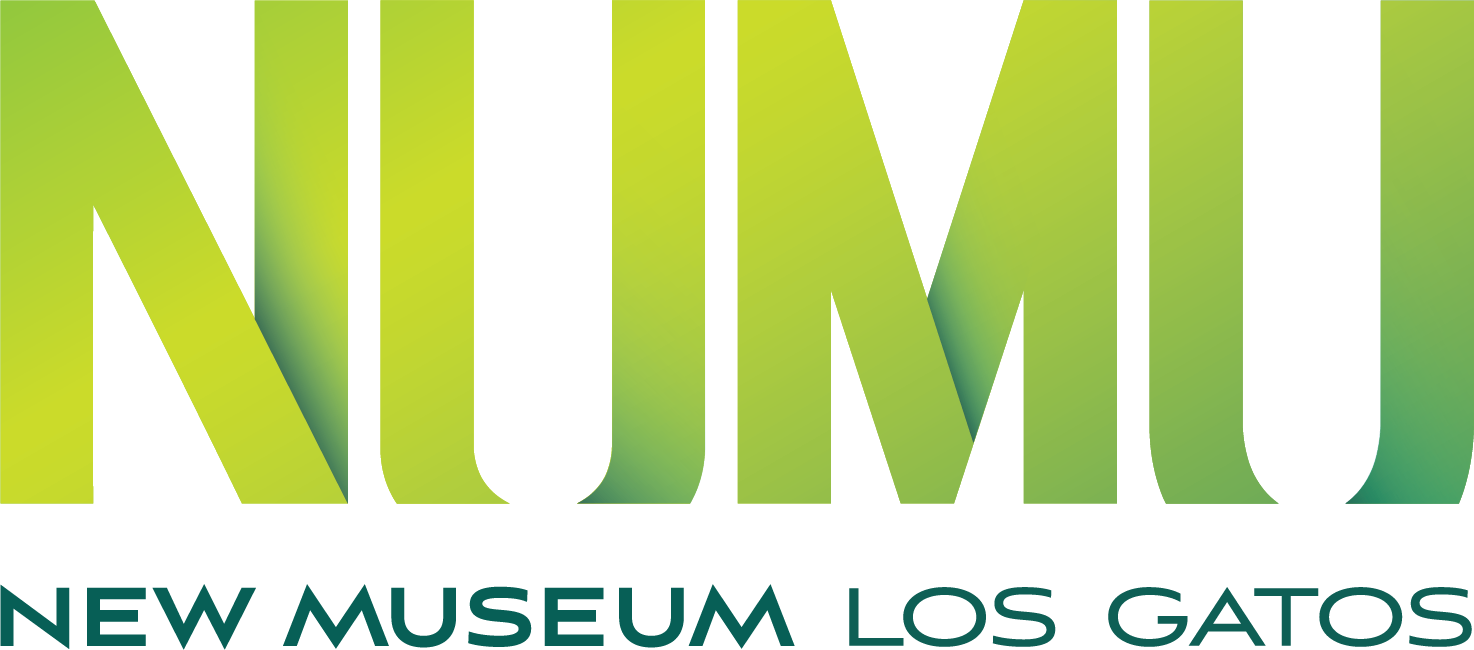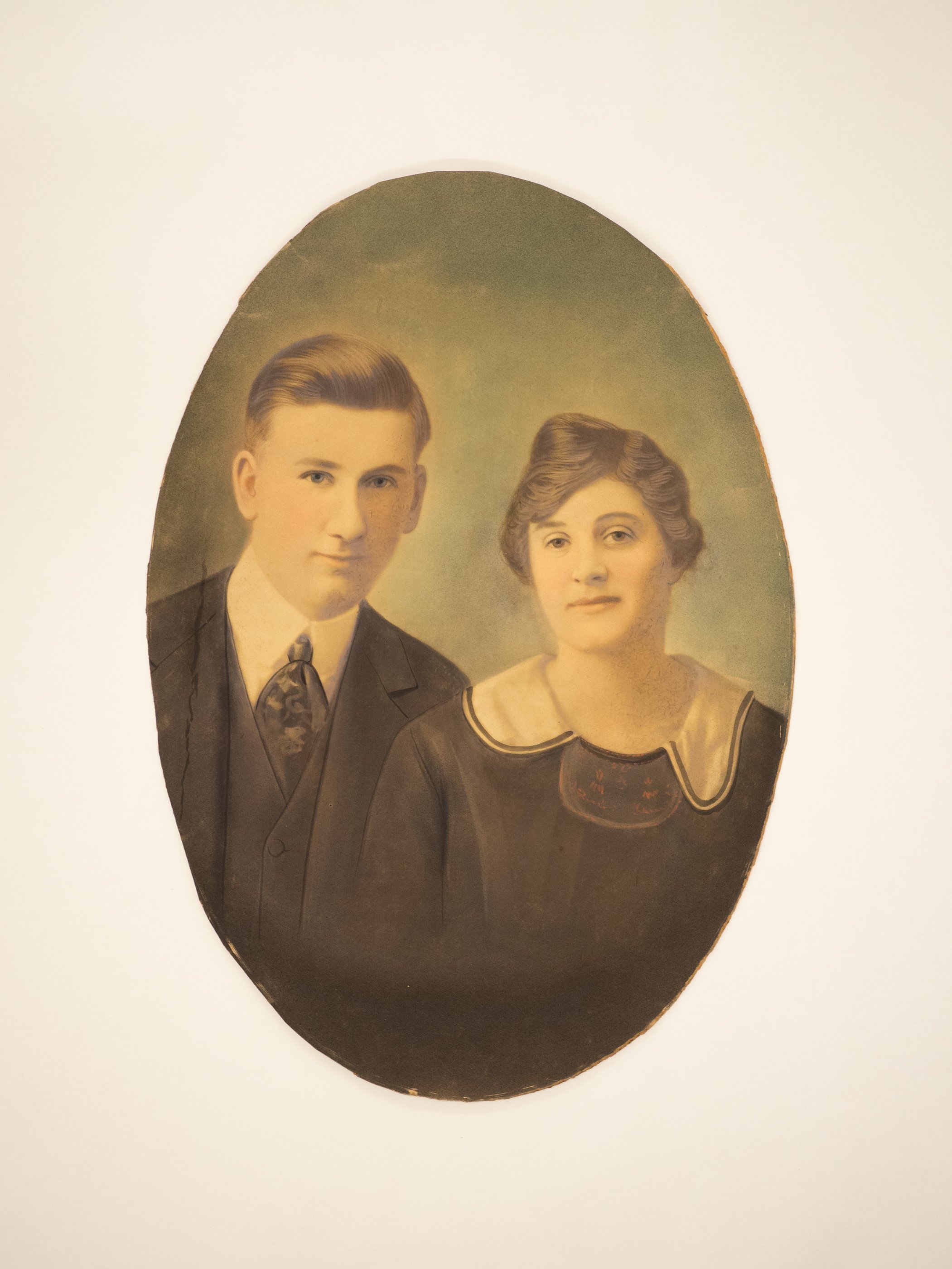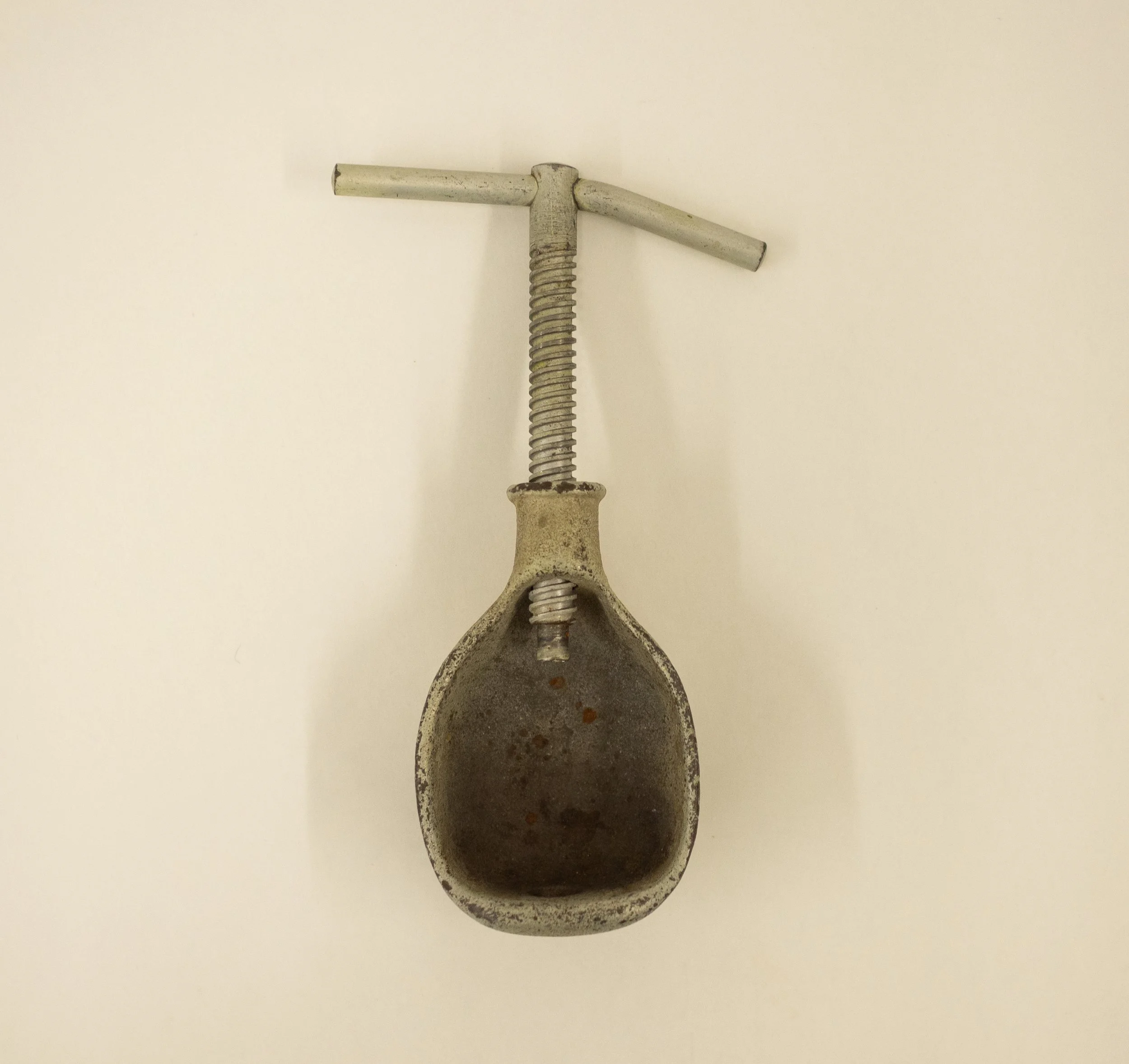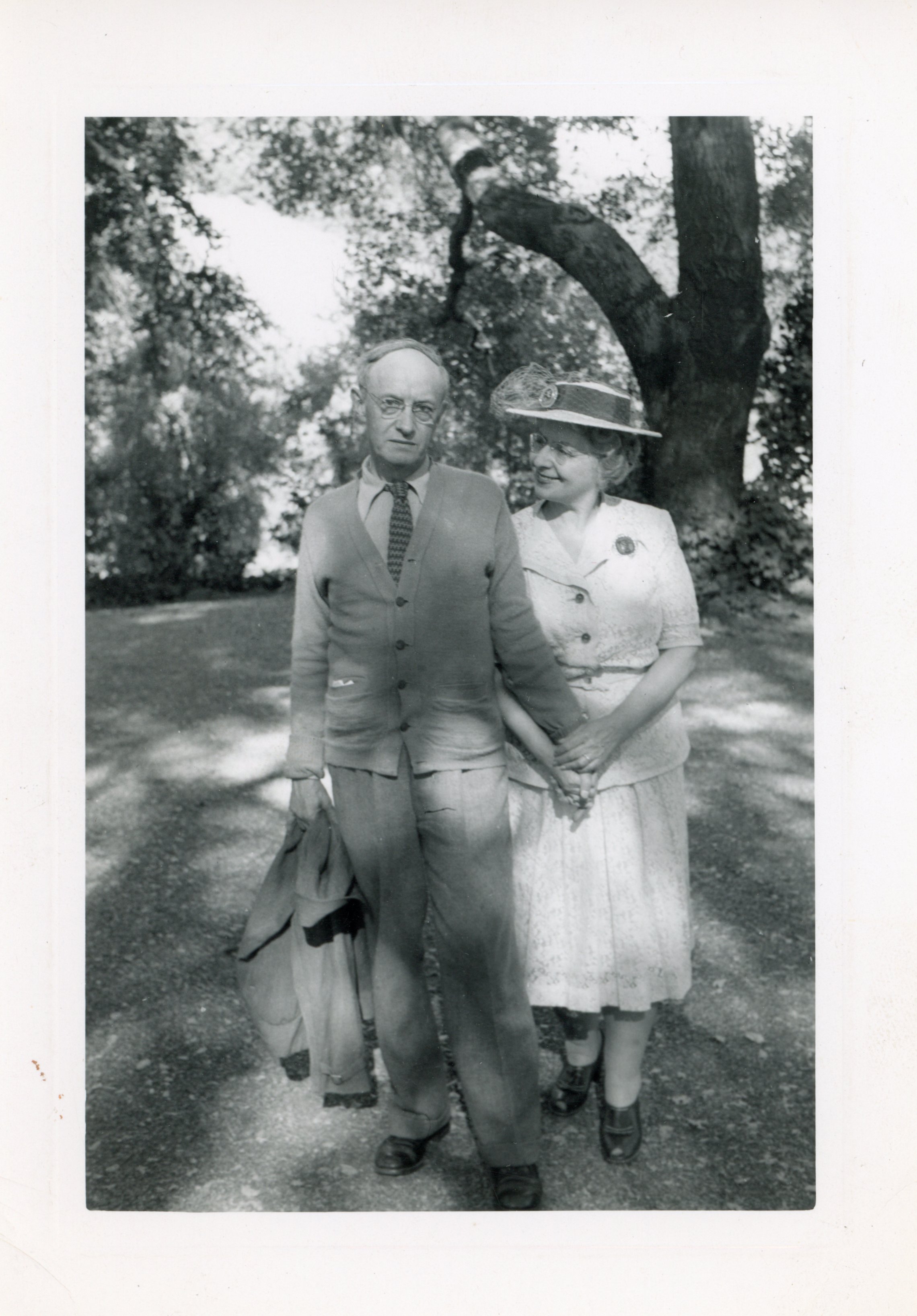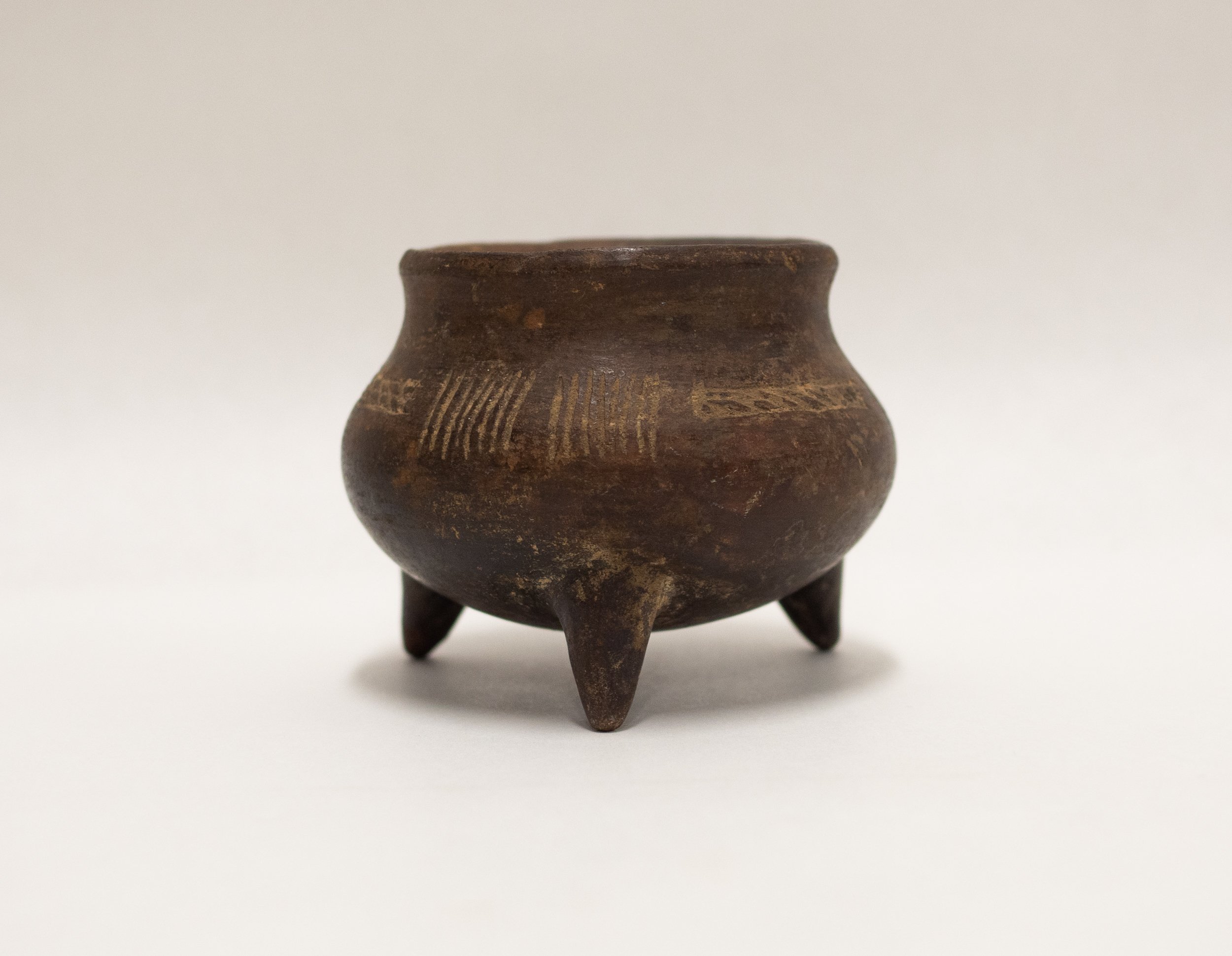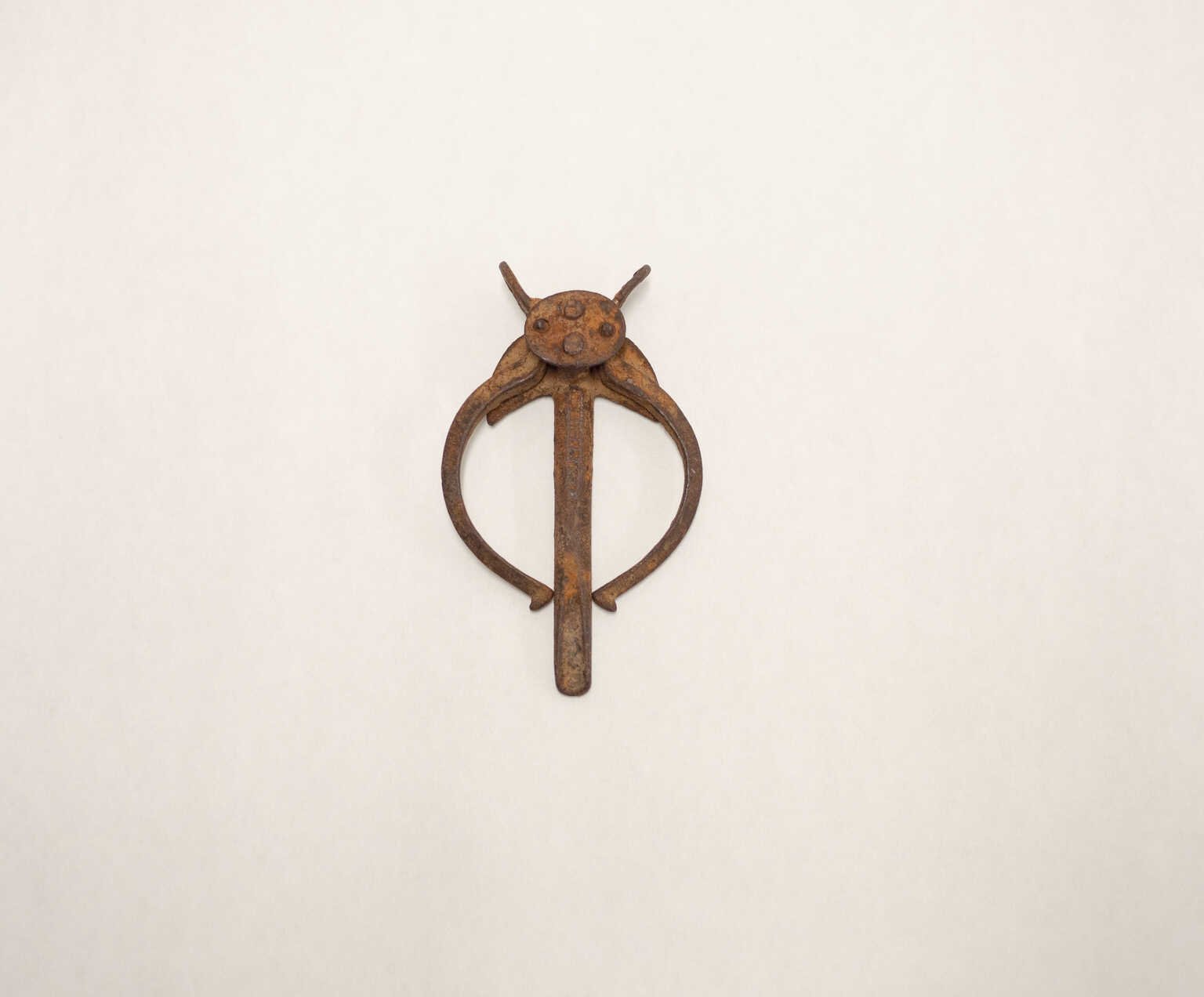An archive of History Mystery objects featured in the LGHP newsletters. Not receiving our newsletters? Sign up here!
September 2023
NUMU collection, NU 2023.138
This month’s History Mystery object is a secret portrait! Last month, Cristiano, the Director of Exhibitions + Collections, was preparing a portrait to be hung in the Collections Lab. The portrait is a hand-painted photograph of a World War I infantryman, or “Dough Boy” that was inside of a gilded oval frame. Before installation, Cristiano removed the frame in order to clean it, and discovered… a second portrait! This hidden portrait was in the frame behind the image of the infantryman, and features a couple in formal clothing. While there is little documentation accompanying these portraits, the man in the couple portrait does slightly resemble the infantryman - it is possible that they are the same person. A note that accompanied the frame identifies “a member of the Freudenthal Family,” although now we are not certain who exactly that note refers to. If you recognize either the infantryman, or the couple depicted, or know anything about the Freudenthal family, we’d love to hear from you. You can reach out to Alexandra at registrar@numulosgatos.org.
July 2023
NUMU collection, NU 2021.156
This month, we bring you the partial mystery of The Golden Poppy pen cap. In the museum’s collection, there is a pen cap that is easily identified as such because it is inscribed with the manufacturing information for a pen and pencil company, the E. Faber Pencil Company. On this cap is the information for a Los Gatos business that specializes in candies, fountain services, and lunch called The Golden Poppy. The Golden Poppy used to be located at 32 West Main Street, which is right behind where Icing on the Cake is today. However, Alexandra was unable to find any information about this business in her research; despite having so much information, there are still questions! Who owned it, when was it in business, and for how long? If you remember visiting The Golden Poppy, and have any information or memories about it that you’d like to share, please feel free to send them to Alexandra at registrar@numulosgatos.org.
May 2023
NUMU collection, NU 2023.195
Recently, Alexandra discovered a small cache of cabinet cards while cataloging. Cabinet cards are a style of photography that was generally used for portraiture between 1870 and 1900. The photographs were large enough to be viewed across the room when displayed on a cabinet, which led to the name “cabinet card.” The cabinet card dominated the commercial portraiture scene for three decades, replacing photo albums. The demand for cabinet cards began declining around 1900 with the introduction of the Kodak Box Brownie camera, when people started taking their own photographs. Many of these cabinet cards were taken at local photography studios, including Souvenir Portrait Studio and Bushnell Foto Company, both located in San Jose.
Unfortunately, the majority of the people in the portraits are unidentified! Recognize anyone? We would love your help in shedding light on these unknown subjects by putting names to faces. Examples of the cabinet cards are included in this newsletter, but you can also go to our online database, select the Archives category, and search for ‘Cabinet Card’ to view all of the cabinet cards cataloged so far. If you recognize anyone pictured, please reach out to Alexandra at registrar@numulosgatos.org and let her know!
March 2023 - History Mystery - Solved!
NUMU collection, NU 2022.96
Last March, Alexandra cataloged an object that she could only describe as a “cat figurine.” It was a small, brass cat statuette, with a tail that looped back and attached to the cat’s head. There was another jagged piece of metal sticking out of the front of the cat’s body, that was a mystery. Everything pointed to the fact that this figurine had some sort of functional purpose, but as nothing on the statue moved or budged, that function was unclear. However, recently this object was identified by our very own Jamie Donofrio, NUMU’s Development + Communications Coordinator, as a lock and key! That mystery piece of metal is actually the key, that is supposed to come out of the cat to lock and unlock the tail, in order to place around items. And many thanks to everyone who responded to last month’s History Mystery! We got multiple responses confirming our suspicions that it was not in fact a cherry pitter, but a nutcracker. That record has also been updated in our online database, thanks to the help of readers like you.
January 2023
NUMU collection, NU 2022.318
Things are not always as they seem, and that goes for labeled objects in museum collections too! This object, recently cataloged, was labeled as a “cherry pitter.” There is no maker’s mark or other information on the object. In an attempt to date the object, Alexandra did some research looking at images of antique cherry pitters. However, most of the images she found for antique and vintage cherry pitters look nothing like this object, which does appear to be too large for typical-sized cherries. Could this object be used instead to remove the pits of other, larger fruits, perhaps the apricots or prune plums that were grown in the orchards that were once so prevalent in the Town’s landscape, and integral to its economy?
Does it have another function entirely? If you recognize this object, or know what it does, we would love to hear from you! You can email Alexandra at registrar@numulosgatos.org with any information you might have, and help us solve this mystery!
November 2022
NUMU collection, NU 2022.250
As Laura has been cataloging items in the Frank Ingerson and George Dennison collection, the team has come across many small “history mysteries.” There are a number of photographs, for example, in which not everyone photographed is identified, or the artwork depicted is not identified as Frank and George creations (as opposed to artworks they collected). As we continue to work through the archive, we are hoping to answer some of these questions. However, if you ever see any item on our online catalog that you have information about, please feel free to reach out by emailing collections@numulosgatos.org! We love receiving missing information about the items in our collection.
As with all the items in our collection, once the cataloging process is completed, we plan on conducting deeper research with the aid of scholars and historians. Currently we are focused on the Frank and George collection, which is the largest, and most extensive, known collection in existence related to the couple. Stay tuned for exciting updates!
July 2022
NUMU collection, 2011.576
This month in History Mystery, we are seeking your help! We have a mystery tool, that we are currently referring to as a “widget,” that was found in a box full of antique tools. This particular tool has no distinguishing marks or features that might hint at its purpose. While the widget is significantly tarnished, there appears to be two smaller pieces, attached with metal rivets/buttons, that could swing out. If you recognize this tool, please let us know! You can email Alexandra with any information you might have at registrar@numulosgatos.org.
May 2022
One ongoing mystery for the LGHP team is the museum’s “Burmese Collection.” Burma, currently known as Myanmar, is the largest country in mainland Southeast Asia. Burma has a long history of kingdoms and empires dating from the 9th century, and was a thriving, peaceful society with a high literacy rate when it fought, and lost, three successive wars against the British, resulting in the complete annexation of Burma into the British Empire in 1886. After World War II, Burma gained its independence from the British, and governed itself democratically until a military coup d’état in 1962, when the country was renamed Myanmar by the ruling military junta. Because most of these items in the museum’s collection were likely collected before 1962, when the country was still known as Burma, NUMU continues to refer to these items as Burmese. The objects in this Burmese Collection are quite varied, and include bowls, cups, dolls, hand fans, figurines, astrology tools, cheroots, and currency. The wide variety of these objects not only speaks to the rich culture of Burma, but also to the amount of trade that Burma did with other Southeast Asian and Asian countries, which would have only intensified as a part of the British Empire. We are not sure yet who collected these objects, under what circumstances they were collected, or how they got to the museum, but we are very happy to have them, and gain a small glimpse into a culture centered halfway around the world.
March 2022 - History (with slightly less) Mystery
NUMU collection, 2011.54.2
In last November’s newsletter, we featured, in this section, a pair of high heels that had the ever-so-tantalizing bit of information indicating they were worn at the signing of the Treaty of Versailles. While we haven’t been able to answer all of our questions about these shoes, we have uncovered more information about them… by unboxing this dress! Last month, Alexandra, our Collections Registrar, uncovered this gorgeous, ornately beaded dress (and its accompanying slip) that is in very good condition; there are hardly any beads missing! Not only is the dress magnificent in itself, but it too had a note: that it was worn by Jeanne Partridge, along with a pair of heels, at the signing of the Treaty of Versailles! We still don’t know exactly who Jeanne Partridge was, or how she came to be one of the thousands of people who witnessed the signing of the treaty, but we are so excited to be able to put a name to these beautiful shoes and dress! Hopefully, someday we’ll have the answers to all of our questions about these objects.
January 2022
NUMU collection, NU 2021.302
Over the course of the Los Gatos History Project, the boxes containing the artifacts in our permanent collections have had to move around a few times, to accommodate the removal of old furnishings, the installation of new furnishings, and the reopening of History Hall. Each time boxes are moved, Alexandra and Cristiano, NUMU’s Exhibitions + Collections Manager, can’t help but peek in the boxes to see what’s inside, and get a preview of what will soon be cataloged. One of these “sneak peeks'' led to the discovery of something truly astonishing - this needlepoint sampler from 1791! Samplers in America date back to the days of the Pilgrims, but are most common beginning around 1790, when immigrants to the New World were established enough to have leisure time. Samplers began as a way to literally sample a variety of stitches that could be used as a pattern in embroidery work, and evolved to become an integral part of a young girl’s education, as well as an important decorative art.
While the colors of the embroidery thread are faded, it is still possible to make out the alphabet, a name (Franke Rikkerts) and the date (1791) at the top of the sampler, making it perhaps the oldest artifact in our collection! How this 230-year old sampler came to Los Gatos, and NUMU, is a complete mystery, but one that we someday hope to solve! If you have any information about this sampler, Alexandra (registrar@numulosgatos.org) and Cristiano (collections@numulosgatos.org) would love to hear from you!
November 2021
NUMU collection, 2011.670.1-2
These gorgeous high-heeled shoes were uncovered during our recent cataloging efforts. They feature a floral black-and-gold brocade and jeweled buttons, and are in very good condition. Unfortunately, there is not much documentation associated with them, except for one very tantalizing piece of information: they were worn at the signing of the Treaty of Versailles, one of history's most significant peace treaties, signalling the end of World War I. The treaty was signed on June 28, 1919 by representatives from Germany, Britain, France, and the United States in the Hall of Mirrors in the Palace of Versailles, but not without controversy. There were a number of punitive measures in the treaty, including stripping Germany of land, requiring Germany to disarm its military, and forcing Germany to accept responsibility for the war and make reparations to many of the Allied countries. Knowing all of this important history surrounding the Treaty of Versailles, the museum has many questions about these heels, namely, who wore them? Why was that person at the signing of the Treaty of Versailles? And how did the heels find their way to Los Gatos? We look forward to someday having these answers.
If your curiosity is as piqued as ours, come see these heels in person, which are currently on exhibit in Los Gatos History Project: Uncovering Untold Stories!
September 2021
While cataloging last month, these two gorgeous clay cooking vessels were uncovered. Despite showing some signs of wear and use, both are in very good condition, without any significant damage that would compromise them structurally. They are quite possibly in exceptionally good condition, considering how old they might be, which is where the mystery comes into play. Both vessels were labeled “pre-Columbian,” which is a generalized term that means something was made by the Indigenous people of an area, before Christopher Columbus and other Europeans came to the Americas in the late 1400s and early 1500s - potentially making these vessels over 500 years old! However, besides basic geographic information (the large rounded vessel was also labeled New Mexico, while the smaller vessel with feet was labeled Panama), there is no other information in NUMU’s records regarding these items. And while having geographic information may appear helpful, in reality, it does not help the museum identify what culture the vessels might have been used by; there are currently seven distinct Indigenous populations in Panama, and 23 in New Mexico - a number which was certainly much higher before the colonization brought on by the arrival of Columbus. What cultures made and used these vessels? Are they really pre-Columbian? How did they get to NUMU? While currently we only have questions, someday we look forward to finding the answers!
July 2021 - History (with slightly less) Mystery
Many thanks to our history-loving public! In March, we posted on NUMU’s Instagram account a photo of Maud Martin who we didn’t know much about, or why the museum has her extensive doll collection. Some time later, we received a package with a plethora of material about Maud. From this information, we now know that Maud, a past resident of Los Gatos, was a photographer of some renown who traveled the world for her art and exhibited at museums such as the de Young in San Francisco! She also participated in local doll shows and exhibitions, sometimes with hand-crafted dolls she made herself.
The LGHP team is so appreciative to have received this contextualizing information for a woman whose dolls are a special part of our permanent collection. It helps us better understand what we have, and why. If you have any information you’d like to share about the people or objects featured in these newsletters or on social media, please don’t hesitate to reach out - Alexandra and Cristiano are standing by!
April 2021
NUMU collection, 2011.604
For this installment of History Mystery, the object is not the center of the mystery, but the story behind the object (also called provenance)! This is a weathered and battered brass plate whose object record included a note from the late 1970s which states the plate was unearthed by a bulldozer adjacent to De Anza College, and that plate belonged to someone on Juan Bautista de Anza’s expedition. The note went on to say that because the plate was brass, it most likely belonged to an officer (an ordinary soldier would most likely have a tin-plated dish), or perhaps de Anza himself.
Juan Bautista de Anza was a Spanish military officer, expeditionary leader, and politician who led a group from Mexico up the California coast to San Francisco; this route is now commemorated as the Juan Bautista de Anza National Historic Trail. There is evidence from de Anza’s journals that he did stop in present-day Cupertino, near Stevens Creek, so it is entirely possible that this plate is from de Anza’s expedition. However, besides this note, we have no other documentation verifying its origins. We would love to learn more about this plate, and about the excavation that unearthed it - if you have any information on the construction near De Anza College, or how this plate made its way to NUMU, reach out and help us confirm the mysterious and exciting origins of this humble plate!
February 2021 - History Mystery - Solved!
The Internet came to our aid in December, helping us to identify some objects recently moved from the Forbes Mill annex (former home to the history exhibits presented by the Museums of Los Gatos, now NUMU) that we were struggling to identify and date. Collections Registrar, Alexandra Schindler, submitted photos of these objects to a subgroup on Reddit - yes, the same platform which recently made headlines in financial news. This “sub”, r/whatisthisthing, is dedicated to the identification of odd, mysterious and random objects people find. And within hours, these helpful strangers gave us the answers we were looking for!
The first object, which truly stumped us, is an ox bow yoke pin, used to secure the yoke to the ox bow. The second object, which looked to us like some sort of jack, but that we could not definitively identify and date, is indeed a jack, but for covered wagon wheels. Both these curious objects date to the mid 1800s, and possibly could have arrived in Los Gatos with settlers on the Oregon Trail.
NUMU collection, 2011.524
November 2020
You sure don’t see something like this everyday! This unique, whimsical object appears to be a hand-painted glass pitcher with a music box built into the base. Who doesn’t like a little music with their drink? We don’t have much history or provenance (a record of ownership; the place of origin or earliest known history of something) on this object. If you know anything at all about this musical vessel, please share by commenting on our blog. Don’t be shy, sometimes the tiniest details prove the most useful!
